214 Search Results for core boards
September 26, 2016
by Carole Zangari -
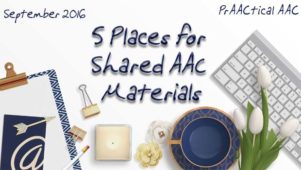
One of the most incredible things about the families and professionals who work in the field of AAC is their willingness to share the materials they create. In this post, we link to some of those wonderful sites where you can go to peruse and use AAC materials for communication, therapy, and classroom instruction. Kudos to all the companies and individuals who work so hard to make this collegiality possible! Speaking of Speech Materials Exchange (AAC) Lesson Pix Sharing Center Boardmaker Online CoughDrop Publicly-shared Boards Smarty Symbols Activity Library We’re just getting started and ready to expand this list in future posts. Do you have favorite places to go for sharing AAC materials? Let us know so we can continue to develop this list.
September 7, 2016
by Carole Zangari -
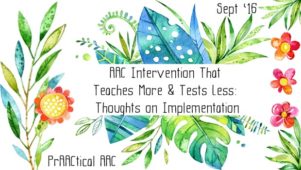
In an earlier post, I shared a graphic on the ways that AAC skills are ‘taught’ versus ‘caught.’ Teaching AAC skills involves the use of specific instructional strategies that give learners information and experiences which result in them being able to communicate more effectively. In many instances, we set out to do just that, but end up with an interaction that ‘catches’ what the student already knows how to do, rather than helping them gain additional skills. There are a few important concepts here. They both have an important role. ‘Catching’ skills isn’t bad. We can do this to figure out what the learner already knows/can do, and give him/her practice with the skill so that it becomes faster and easier to produce. When our interactions ‘catch’ a skill, we’ve created (or taken advantage of) an opportunity for communication. That’s important BUT, it isn’t teaching them anything new. Our learners do... [Read More...]
July 17, 2016
by Carole Zangari -
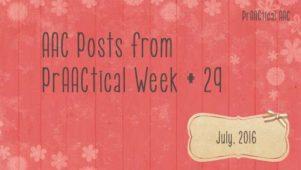
Monday – Make It Monday: Manual Communication Boards with Core Vocabulary Wednesday – Video of the Week: AAC in the Classroom for Students with Significant Disabilities – Implementation & Data Collection Thursday – PrAACtical Supports for Young AAC Learners: Recipes for Success, Part 2
April 18, 2016
by Carole Zangari -
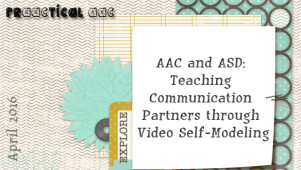
It is an honor to have Dr. Joanne Cafiero, an AAC consultant for individuals with complex communication needs and Autism Spectrum Disorders, as a guest contributor for today’s post. Dr. Cafiero is the author of Meaningful Exchanges for People with Autism an Introduction to AAC (2005). She is a consulting editor for Focus on Autism and Other Developmental Disabilities and has guest edited several of ASHA’s Perspectives in AAC. She was a member of the National Academy of Sciences Committee on Educational Interventions for Children with Autism (2001) and is currently working on an update on AAC and Autism for the Academy. In this post, she shares some of her work on video self-modeling. ::::::::::::::::::::::::::::::::::::::::::::::::: Growing research and first-person reports are illuminating the unique sensory and motor differences experienced by people on the Autism Spectrum. This new information has a huge impact on the AAC practitioner. Motor planning differences in ASD can... [Read More...]
March 17, 2016
by Carole Zangari -
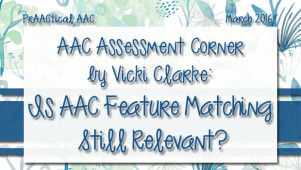
Today, we welcome back Vicki Clarke, a regular contributor to PrAACtical AAC, with another edition of AAC Assessment Corner. In this post, Vicki shares her thoughts on feature matching for AAC device selection. ::::::::::::::::::::::::::::::::::::::::::::::::::::::::::::::::::::::::::::::::::::::::::::::::::::::::::::::::::::: Feature matching has been the gold standard for AAC evaluation for the last 20 years. It is research based and clinically proven as the best technique for selecting an AAC solution for an individual. The tide of real-life practice, however, is turning and there has been increasing discussion at conferences, in social media and blogs questioning why we continue to use feature matching to place AAC systems in the hands of students. In a recent assistive technology on-line chat, a noted AT specialist remarked: “I wonder if at a district level it might not be better to have a go-to AAC system everyone tries first. If that doesn’t work then adjust.” Does this mean that we throw... [Read More...]
January 18, 2016
by Carole Zangari -
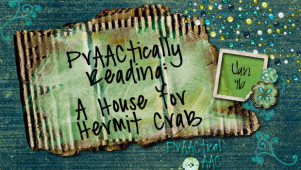
Storybook reading is rich with potential for building AAC, language, and literacy skills. An added bonus: It’s an activity that educators, therapists, and families can all use and enjoy. In this post, we explore ways to use A House for Hermit Crab, by Eric Carle, for AAC and language learning. Key Instructional Strategies Having an engaging book gives us a good start on the lesson, but the learning comes from the interaction. Shared reading can be done in therapy one-on-one or as a group in class. Either way, the adult leading the activity will need to be well-versed in instructional strategies that facilitate AAC learning. These include: Aided language input RAAP Feedback Goal Areas: Language and Communication There are lots and lots of ways to use this book for literacy learning, but in this post we’ll focus more on the development of communication and language skills. Here are some goal... [Read More...]
December 31, 2015
by Carole Zangari -

Goodbye, December! Before we turn the calendar page, here are some of the most popular posts of 2015. Many thanks to Lauren Enders, Rachael Langley, and all of our guest bloggers for being so generous with their time and expertise. I couldn’t do it without you!! 5 Great Resources for Pre-Made Communication Boards How I Do It: Writing IEP Goals for Students Who Use AAC with Lauren Enders How I Do It by Rachael Langley – PODD in the Classroom: Portable, Wearable, & Comfortable How I Do It: Using PODD books and Aided Language Displays with Young Learners with Autism Spectrum Disorder Core Samples Teaching Core Vocabulary A Year of Core Vocabulary Words Pivotal Skills for AAC Intervention: Aided Language Input Literacy for Everyone with Adapted Books Communication Boards: Colorful Considerations 30 Ways to Celebrate Autism Awareness Month
October 27, 2015
by Carole Zangari -
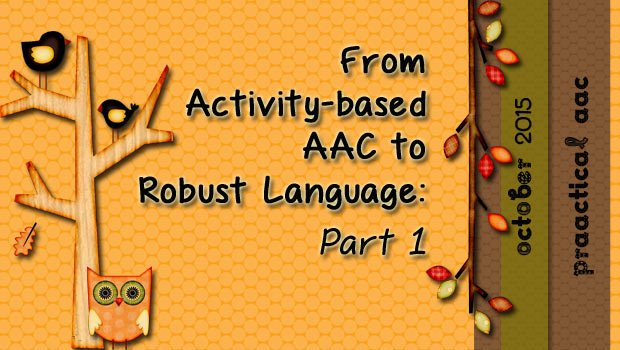
As far as I can tell, most AAC learners are taught by people who don’t specialize in AAC. Their school SLPs may have caseloads of 50, 60, 70, or more students with IEPs, 90% of whom have goals for articulation, language, and fluency. Their classroom teachers serve students whose disabilities range from none at all, to dyslexia to cerebral palsy, to significant intellectual disabilities, and everywhere in between. In all likelihood, neither group had much AAC training. What little AAC they know, they’ve picked up on their own from reading, going to workshops and conferences (usually self-funded), talking to colleagues, and exploring online resources. Many times, their first foray into AAC is with things like choice boards and visual supports, such as daily schedules and first/then boards. From there, they may begin labeling the environment with pictures symbols (e.g., ‘table’ on the table, ‘on/off’ near the light switch), using mini-schedules... [Read More...]
October 19, 2015
by Carole Zangari -
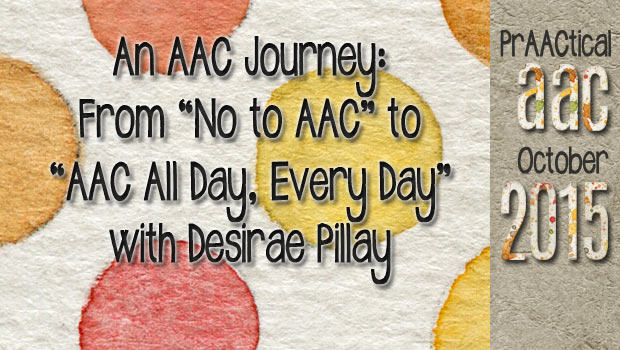
What better way to celebrate AAC Awareness Month than to share AAC stories from around the world? In this post, we welcome Desirae Pillay, who shares a bit about her daughter, Savannah, and their AAC journey. As the mother of a young adult with ASD and cerebral palsy, Desirae has taken what she has learned about AAC and is using it to help others outside of her family. Desirae began her journey with AAC in 2003 when she could not find a qualified AAC specialist to assist her with her daughter. Her experience and informal learning gained her a job for an AT company. When her daughter’s health needs became pressing, she resigned her job and worked part time as a Disability Consultant for various organisations. Desirae recently returned to work as an AT Advisor, where she trains on a range of topics about communication for people with disabilities. Her passion is for... [Read More...]
July 16, 2015
by Carole Zangari -
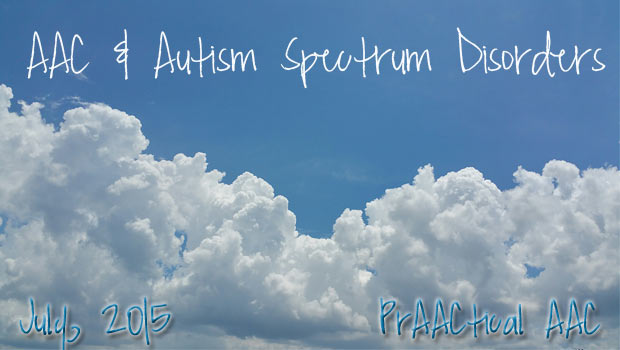
In Robin’s honor, we revisit some of her most popular posts. Please share them with people who might find them helpful. Beyond Requesting: Let’s Chat with Peers Begin AAC Now: 10 Things to Do AAC Must-Have’s for the Classroom and Therapy Room The First 12: Getting Started with Core Words Literacy For Everyone with Adapted Books Beyond Requesting: Using Scripts to Teach Conversation AAC Goals That Matter Creating Communication Boards: There are Lot of Apps for That! Join Together: Core and Fringe Vocabulary 30 Ways to Celebrate Autism Awareness Month









